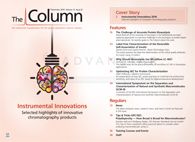The Challenge of Accurate Protein Bioanalysis
In recent years, liquid chromatography–tandem mass spectrometry (LC–MS/MS) methods have been increasingly adopted as a replacement for ligand‑binding assays to monitor the fate of drugs in vivo. Such bioanalysis of protein-based pharmaceuticals (biopharmaceuticals) is more challenging, however, than it is for small-molecule drugs. Rainer Bischoff of the University of Groningen in the Netherlands has been exploring approaches to overcome these challenges. He recently spoke to us about this work.
Photo Credit: Frank Rohde/Shutterstock.com

In recent years, liquid chromatography–tandem mass spectrometry (LC–MS/MS) methods have been increasingly adopted as a replacement for ligandâbinding assays to monitor the fate of drugs in vivo. Such bioanalysis of protein-based pharmaceuticals (biopharmaceuticals) is more challenging, however, than it is for small-molecule drugs. Rainer Bischoff of the University of Groningen in the Netherlands has been exploring approaches to overcome these challenges. He recently spoke to us about this work.
Q. Why is accurate bioanalysis of protein pharmaceuticals difficult? What are the advantages of LC–MS/MS over ligand-binding assays for this purpose?
A: The accurate analysis of proteins in complex biological samples such as blood (plasma or serum) or tissue is difficult for a number of reasons. First, proteins are highly complex and contain many different functional groups. Proteins may be positively charged on one side while being negatively charged on the other. They may have hydrophobic regions next to hydrophilic regions and they may be hydrogen-bond donors as well as acceptors. Adding to this complexity is the inherent heterogeneity of proteins, whether endogenous, as in the case of biomarkers, or recombinant, as in the case of biopharmaceuticals. It is thus a simplification to speak of “a protein”, since we know from many studies that all proteins form “protein families”. The terms protein species and proteoforms have been coined to reflect this fact.
In light of this situation, how can “a protein” be accurately quantified? Well in fact, it can’t. As outlined in our recent review (1), we need to be aware of the fact that the measured amount or concentration of a protein depends on the methodology. With the advent of LC–MS/MS as an alternative method for protein bioanalysis, there are more and more reports showing a discrepancy between results from ligandâbinding assays (generally enzyme-linked immunosorbent assays [ELISAs]), and LC–MS/MS assays based on proteotypic or signature peptides. We should not be surprised to see such discrepancies, which are highly uncommon for smallâmolecule assays, because ELISAs and LC–MS/MS measure different parts of a protein. ELISAs are based on antibody recognition of an epitope, be it linear or conformational, while LC–MS/MS assays quantify peptides based on mass-to-charge ratios (m/z) of precursor and fragment ions (so-called transitions) of peptides after proteolytic digestion. In ligand-binding assays, recognition between a protein and an antibody may be interfered with by competing ligands in the sample or by modification of the epitope (chemically or enzymatically). An antibody may also recognize related or even unrelated proteins in a sample, as recently highlighted by researchers advocating a better quality control of antibodies to avoid irreproducible or erroneous results (2). LC–MS/MS, however, is not free of artefacts or interferences either. Any chemical or enzymatic modification of a signature peptide will change its m/z value and thus move it out of the detection window of the mass spectrometer for the most widely used selected reaction monitoring (SRM) method. Protein digestion may pose another challenge to accurate protein quantification by LC–MS/MS unless a protein standard is available that is labelled with a stable isotope but otherwise is identical. However, such standards are usually not available. We have investigated the importance of internal standards and protein digestion (3,4) but this research can only give insights for a limited number of cases. All of these considerations make protein bioanalysis rather different and more complicated than small-molecule bioanalysis.
This brings me to another important point, namely the question of standards and reference materials for proteins. Any quantitative analytical or bioanalytical method must be calibrated, meaning that a correctly quantified, pure standard is needed. Considering the above argument that there is no such thing as “one protein” but that we are generally dealing with protein families, what is then an appropriate standard for calibration? This poses a dilemma for ELISAs and LC–MS/MS assays alike. The problem of standards and reference materials has received considerable attention and is deemed to contribute to a large part of the reproducibility problems in biosciences (5).
The second part of your question, regarding the advantages of LC–MS/MS over ligand-binding assays, is thus not easy to answer. Technically speaking, LC–MS/MS assays are more precise and can have superior technical reproducibility, notably if appropriate standards are included. However, accuracy may remain an issue, as outlined above. An important question in the case of biopharmaceuticals is whether the free fraction, the bound fraction, or the total fraction should be quantified. The answer depends on the purpose of the bioanalytical assay (for example, whether you want to know the active fraction or the total amount). Lastly, biotransformation of biopharmaceuticals may also affect analytical results and more importantly pharmacological activity. We have recently shown that a therapeutic monoclonal antibody deamidates in the circulation of breast cancer patients and that the rate of deamidation may differ between patients (6). This new field of “drug metabolism” will likely see much more activity in the future.
Protein bioanalysis is a fast-moving field and simple answers, such as to questions about which method is “better” than another, are not easily forthcoming. As analytical chemists, we should always strive to understand what we measure and to be aware of possible interferences. There is no “one size fits all” in protein analysis or bioanalysis.
Q. In the bioanalysis of proteins, typically one signature peptide is used. What are the limitations of this approach?
A: In the context of the above, it is preferable to look at more than one peptide from a protein for confirmatory evidence. A signature peptide may be subject to modifications affecting its quantification. If this peptide is used as a surrogate for the entire protein, protein quantification may be affected by modifications of a single peptide. However, if two or more peptides are measured, they may deliver different results from each other, and this is hard to reconcile with reporting results to regulatory authorities or with the processes in a regulated bioanalysis environment (for example, at a contract research organization, pharmaceutical company, or clinical laboratory). The current tendency is thus to quantify proteins based on one peptide and to monitor another one or two peptides for confirmatory evidence. The same also goes for the numbers of transitions that are being used for quantification of one peptide. Usually one transition is used as “quantifier” while others serve as “qualifiers”.
Q. In a recent study, you analyzed the in vivo biotransformation of trastuzumab and its deamidation products in human plasma (6). An important difference between your approach and previous methods is that you measured two signature peptides, instead of one. How did you choose the signature peptides to measure?
A: The first signature peptide was chosen with the goal in mind to quantify the biotransformation at Asn55 in one of the binding sites of trastuzumab to its pharmacological target. There was thus not much choice as the peptide had to cover this site. The second peptide was chosen from a region of the antibody that is not prone to modifications to relate the total amount of trastuzumab to the various forms resulting from in vivo biotransformation at Asn55. This allowed us to “normalize” our results, if you will, and to determine the percentage of transformation products. We thus had a very specific goal in mind for this assay.
Q. For LC–MS/MS analysis, it is necessary to digest protein samples. How did you avoid deamidation during digestion and thus enable reliable monitoring of the actual deamidation that occurs in vivo? Can a similar approach be taken to avoid causing other types of protein modifications during digestion, such as glycosylation or oxidation?
A: We studied the pH-dependence of Asn55 deamidation to find a compromise between maintaining sufficient trypsin activity and avoiding chemical deamidation at basic pH values. These conditions were specifically optimized for this purpose and cannot be generalized for other types of modifications or even for deamidations at other sites, which may be more pH-sensitive. We have to take a case-by-case approach to this type of analysis. Our work bears no relation to the stability of glycosylations, notably the stability of sialic acid linkages or the occurrence of oxidations, notably Met-sulfoxide formation, which require different kinds of precautions.
Q. When you applied this method to plasma samples taken from breast cancer patients taking trastuzumab, what did you find?
A: In fact we found that deamidation at Asn55 occurs in vivo and that the rate of deamidation may be different between different patients. We are currently investigating whether deamidation at Asn55 has a relation to therapeutic efficacy, bearing in mind that there are likely many more in vivo biotransformations and that other factors like tissue distribution or the level of circulating targets will affect pharmacological efficacy. Our work reveals the tip of an iceberg and will hopefully incite other researchers to perform similar studies.
References
- P. Bults, N.C. Van De Merbel, and R. Bischoff, Exp. Rev. Proteomics 12, 355–374 (2015).
- A. Bradbury and A. Plückthun, Nature518, 27–29 (2015).
- K.J. Bronsema, R. Bischoff, and N.C. van de Merbel, Anal. Chem.85, 9528–9535 (2013).
- K.J. Bronsema, R. Bischoff, and N.C. van de Merbel, J. Chromatogr. B893–894, 1–14 (2012).
- L.P. Freedman, I.M. Cockburn, and T.S. Simcoe, PLoS Biol.13, e1002165 (2015).
- P. Bults, R. Bischoff, H. Bakker, J.A. Gietema, and N.C. van de Merbel, Anal. Chem.88, 1871–1877 (2016).
Rainer Bischoff is a Professor and the Head of the Department of Analytical Biochemistry at the University of Groningen in the Netherlands.
E-mail: r.p.h.bischoff@rug.nl
Website: www.biomac.nl

Altering Capillary Gas Chromatography Systems Using Silicon Pneumatic Microvalves
May 5th 2025Many multi-column gas chromatography systems use two-position multi-port switching valves, which can suffer from delays in valve switching. Shimadzu researchers aimed to create a new sampling and switching module for these systems.
Studying Cyclodextrins with UHPLC-MS/MS
May 5th 2025Saba Aslani from the University of Texas at Arlington spoke to LCGC International about a collaborative project with Northwestern University, the University of Hong Kong, and BioTools, Inc., investigating mirror-image cyclodextrins using ultra-high performance liquid chromatography–tandem mass spectrometry (UHPLC–MS/MS) and vibrational circular dichroism (VCD).

.png&w=3840&q=75)

.png&w=3840&q=75)



.png&w=3840&q=75)



.png&w=3840&q=75)












